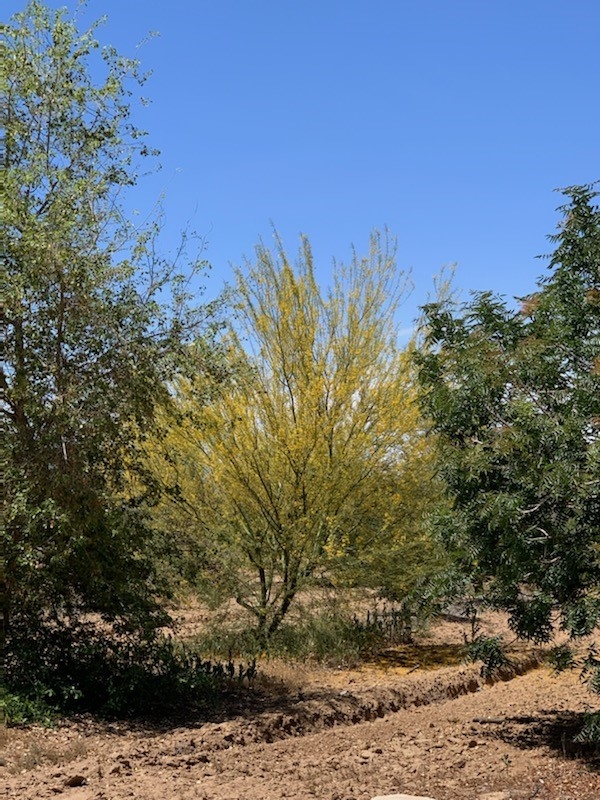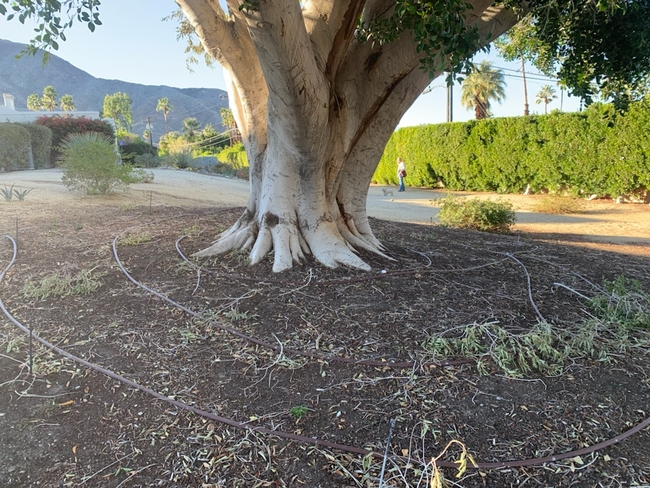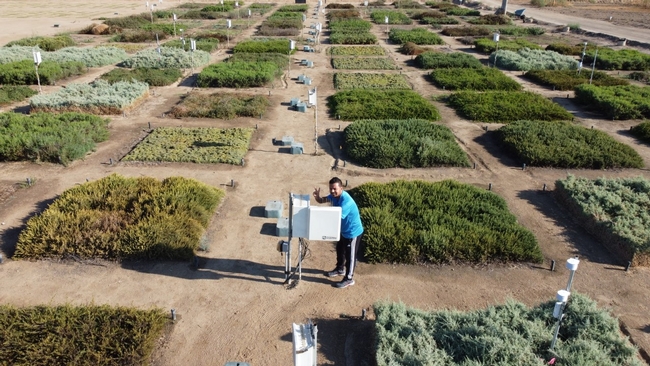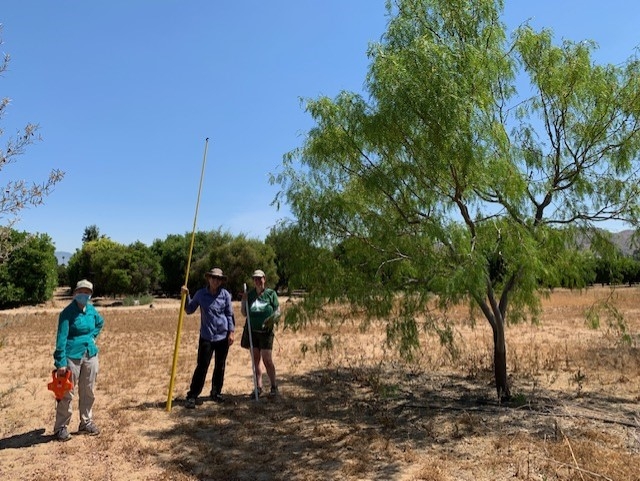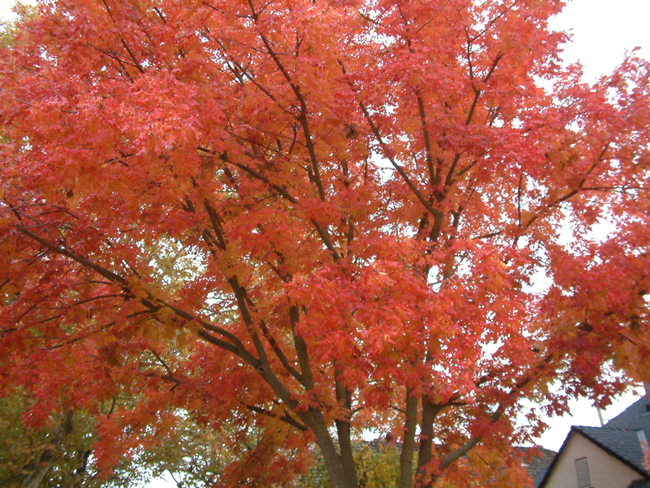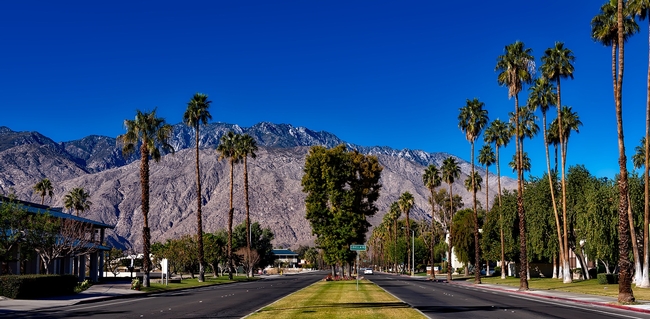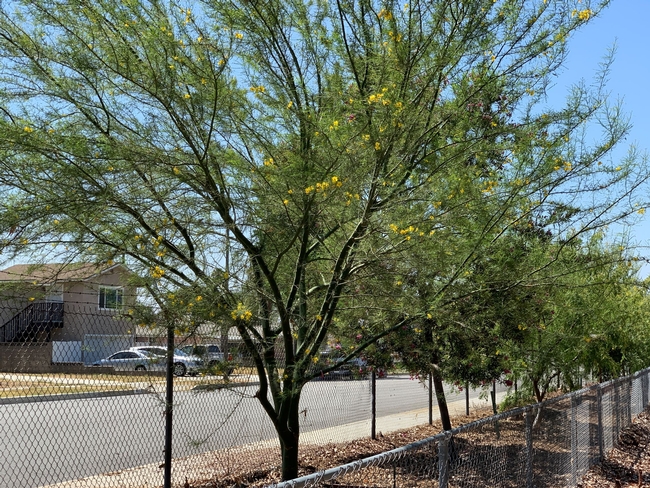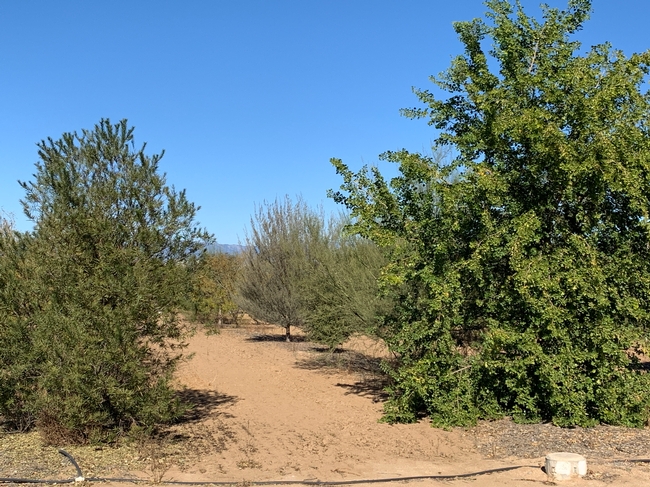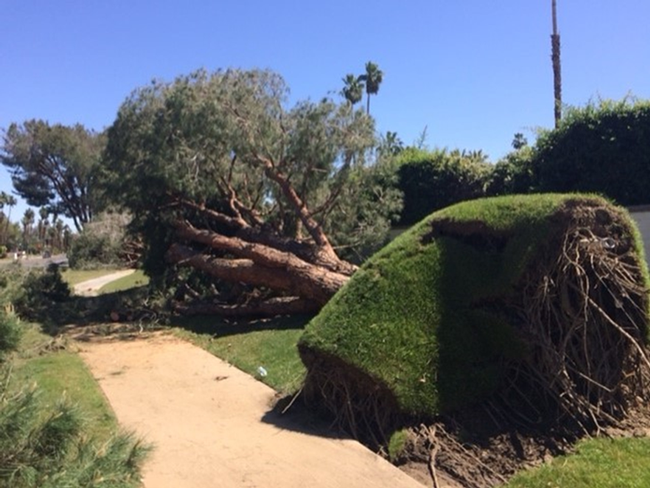
Posts Tagged: Janet
Save trees first: Tips to keep them alive during drought
Trees essential to lowering temperatures, cooling ‘heat islands'
Water restrictions prompted by the drought are driving Californians to prioritize how they will use their limited water. Because landscape irrigation is a major water use for many households, residents are looking outdoors to conserve water.
When choosing which landscape plants to save, “trees come first,” said Janet Hartin, UC Cooperative Extension area environmental horticulture advisor for San Bernardino, Los Angeles and Riverside counties. “Healthy communities need trees. Fortunately new California water restrictions allow for provisions to ensure trees receive adequate water to stay alive and healthy.”
“Mature trees are instrumental in cooling urban heat islands and we can't afford to lose them and start all over,” Hartin said. “Shade from mature trees can reduce surface temperatures by as much as 65 degrees in asphalt-covered parking lots. Shade from a single tree can reduce these surface temperatures from 165 to less than 100 degrees when air temperatures reach 110 degrees. Even with air temperatures in the 90s, surface temperatures can reach 140 degrees.”
In addition to providing shade, trees absorb and store carbon dioxide, release oxygen, enhance pollinators and wildlife habitat, filter pollutants from air and water and can reduce energy use, according to Hartin. Because trees take years to grow, they aren't as easily replaced as other plants.
As residents let lawns go brown, she recommends watering trees that are near or surrounded by lawn.
“If a tree is in the middle of a lawn, it is almost certainly watered by lawn irrigation,” Hartin said. “If it's not on a separate drip system, drag out a hose and allow the water to slowly trickle into the soil early in the morning or in the evening. Deep watering for two hours once every couple of weeks will keep most established trees alive."
In most jurisdictions, watering restrictions do not apply to hand watering and hand-held watering devices such as hoses, which may be used for longer periods of time than the restrictions permit otherwise. However, watering may be restricted in all cases to prescribed times of day.
“Check to see if your jurisdiction also requires a hose shutoff valve,” Hartin said.
“For fruit trees, we may have to forgo fruit production for a year or so. There may not be enough water to support fruit production, but the goal is to keep the trees alive during the drought,” she said.
She recommends watering trees away from the trunk, halfway between the trunk and the dripline – where the foliage ends and rain drips off the leaves – because “roots grow outward quite a distance as well as downward. Leave the hose on so the water is just trickling out,” she said. “You want water to seep into the soil and encourage the roots to grow deeper. The slow water flow will seep down a foot or so and the roots will follow, which will help anchor the tree. Move the hose around every half hour to hour in quadrants around the tree for more even watering.”
Don't have time to move the hose? Hartin suggests getting a soaker hose and wrapping it in concentric circles 2 to 3 feet apart.
“Soaker hoses are made from recycled tire rubber and allow water to slowly ooze out of the pores along the hose, distributing the water fairly evenly throughout the hose length. Avoid using soaker hoses longer than 75 feet due to pressure issues.”
To reduce evaporation around the tree, spreading mulch a few inches from trunk can help.
“Dark mulches can heat the environment so it's best not to use them,”Hartin said. “If you are in a fire-prone area, don't use organic wood-based mulches because they are flammable. Use decomposed gravel or pebbles, rock-based products instead. To keep sunlight out and discourage weeds, large wood chip mulches should be maintained 3-4-inches deep and smaller inorganic mulches at 1-2 inches.”
Residents may want to maintain some grass for children and pets because bare feet and paws can sustain serious burns on surfaces hotter than 120 degrees.
“People don't realize how hot fake grass can get,” Hartin said. “Research I conducted last summer in the Coachella Valley and Redlands found that surface temperatures of synthetic lawns can be more than 65 degrees higher than living turf and groundcover surfaces on several dates in between May and August.”
For California lawns, there are drought-tolerant grasses that can thrive on 30% less water than bluegrass and other cool season varieties. Examples are buffalograss and bermudagrass. They still require maintenance, such as mowing, but are great for play and recreational surfaces for people and pets.
Jim Baird, UC Cooperative Extension turf specialist based at UC Riverside, said, “Turfgrasses offer numerous recreational, aesthetic, and environmental benefits including player safety, property value, mental health, erosion control, groundwater recharge and surface water quality, organic chemical decomposition, carbon sequestration and environmental cooling.”
There are also non-turf groundcovers that are drought resistant.
“As they transpire, plants cool the environment. We have more and more drought-resistant alternatives to high-water-requiring plants on the market now, and that's where we should be going,” Hartin said.
For people considering replacing their lawns and adding new landscape plants, she recommends planting low-water using groundcovers in the fall.
“It's too hot to plant in summer and even native and drought-resistant plants require water several times week until they get established,” she said.
Most counties have a UC Master Gardener Program with a helpline staffed by well-trained volunteers dispensing advice to help keep plants alive and recommend plants that are well-suited for the local environment. Find a local UC Master Gardener Program at https://mg.ucanr.edu/FindUs.
University of California Cooperative Extension
Drought and Landscape Tree Care Resources
Keeping Plants Alive Under Drought and Water Restrictions (English)
https://anrcatalog.ucanr.edu/pdf/8553.pdf
Mantener las plantas del exterior vivas con poca agua (Spanish)
https://anrcatalog.ucanr.edu/pdf/8628.pdf
Prioritizing Trees Under Drought and Water Restrictions (5-minute video)
https://www.youtube.com/watch?v=CTKLlJgdLVk
Tips to Keep Your Landscape Trees Alive During Drought
Landscape Tree Irrigation to Maximize Tree Health, Benefits, and Beauty
Landscape Tree Irrigation 101
Top 10 Ways to Conserve Water in Your Landscape and Garden
Use of Graywater in Urban Landscapes in California
https://anrcatalog.ucanr.edu/Details.aspx?itemNo=8536
The importance of trees to cool urban heat islands
Partnering for California
Spring 2021 proved to be one of the hottest in California, breaking heat records in several cities. It was a perfect opportunity to plant “climate-ready landscape trees” in inland cities identified in a study conducted by the University of California Cooperative Extension in partnership with the U.S. Forest Service.
The idea of bringing together community groups and volunteers to enhance tree canopies that cool urban heat islands --which can be more than 50 degrees hotter than surrounding areas -- in the Redlands area was spawned by Janet Hartin, UC Cooperative Extension environmental horticulture advisor for Riverside, San Bernardino and Los Angeles counties.
It became a reality when Mandy Parkes, district manager of Inland Empire Resource Conservation District, and Shelli Stockton of the University of Redlands received partner grants from the Climate Action Corps to start a nursery and get the “climate-ready landscape trees” in the ground. To date, nearly 100 trees from the study have been planted, including over 40 at the Redlands Sports Complex. As the volunteers in Redlands know, planting trees helps to cool these heat islands. After a long day of digging and planting in June, the volunteers were satisfied with their hard work and looked forward to sharing their experiences.
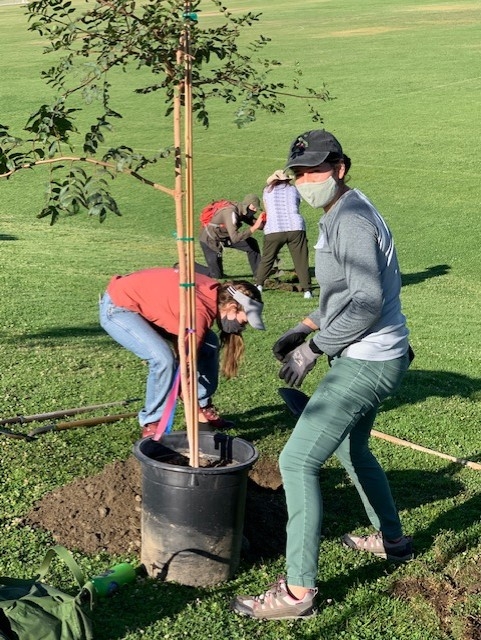
According to Parkes: “The project is moving along quickly due to excellent work of the Climate Action Fellows; inspiring research and support from Janet Hartin and the UC Cooperative Extension Master Gardeners who will ensure that residents continue to receive proper tree care help long after the planting ends; outreach by Mario Saucedo and his Redlands-based community action nonprofit organization, Common Vision Coalition.”
Saucedo, chairman of Common Vision Coalition, said, "It came together, all of us round-tabling on how we could do this pilot project and reach out to the community residents and offer them free trees for their homes."
Once the community accepted the project, the outreach began. James Berry of the California Climate Action Corps was excited after they got the green light from the city of Redlands to plant the trees.
"They are from two different species," said Berry. "The Western Bud and the Red Push Pistache. Both are heat tolerant and drought tolerant, making them ideal for the high temperatures we are facing, and the ones in the coming years as a result of the climate change."
“Our ‘Trees for Tomorrow' workshop we held last fall for city planners, wholesale and retail nursery personnel, landscape architects, landscapers, water districts community groups, and Master Gardeners resulted in pockets of multidisciplinary projects, tree planting projects across Southern California, including the Redlands project. The Redlands project exemplifies the core principles of a well thought out and executed project that includes long-term tree care, a real key to maximizing benefits of trees over their lifespans of 50 years and more.”
With a statewide drought forcing water restrictions, people are looking into options to save water. Hartin advises against sacrificing any trees.
"One of the things that I think is important to prioritize is to make sure that when we have to reduce our water use outside in urban areas, we maintain our trees as a top priority," said Hartin. "If that means for a year or two that our lawns and our flowering beds are going to go by the wayside, then that's just the situation."
She recommends something as simple as dragging a hose out and into the tree's drip line, making sure not to water the trunk, but the other side of the drip line where the active root system is.
"Climate-ready tree study: update for Southern California communities" by E. Gregory McPherson, Alison Berry, Natalie van Doorn, Janet Hartin, Jim Downer, Darren Haver and Erica Teach is published at https://www.fs.usda.gov/treesearch/pubs/60414.
To learn more about the study or how to combat climate change with trees:
“Trees for tomorrow start today.”
“Lush urban forest can help communities face climate change.”
Plant a Tree. Leave a Legacy!
Do you have Spring Fever? If you have adequate space, why not leave a legacy to your children's children by planting a tree? When the right species is planted in the right location with the right care, landscape trees can be enjoyed for 100 years or more. Landscape trees cool urban heat islands, absorb carbon dioxide, filter toxic chemicals from soil preventing them from polluting our waterways, reduce soil and water erosion, reduce internal energy needs and related costs, provide habitat, and beautify neighborhoods.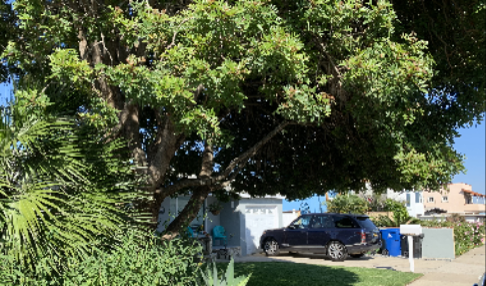
Spring is a much better times to plant a container landscape tree in California than is summer. Trees incur far less stress if they've been in the ground several weeks rather than having to immediately adapt to high summer temperatures. Cooler weather allows plants to establish roots in their new ‘home' before the harshness of summer sets in. (Deciduous bare-root fruit trees, on the other hand, should be planted during the winter when they are dormant.) Choose recommended species for your climate and micro-climate.
Choose trees based on your Sunset climate zone (more precise than USDA zones for California since they include impacts of high temperatures as well as low temperatures) and your microclimate (shade, soil conditions, space, etc.). Four of my favorite search engines that allow one to search by multiple criteria (size, water needs, flower color, ecosystem functions, pest susceptibility, etc.) are: Inland Valley Garden Planner: https://inlandvalleygardenplanner.org/; Cal Poly, Pomona: https://selectree.calpoly.edu;California Native Plant Society: http://www.cnps.org/cnps/grownative/lists.php; and WUCOLS IV (Water Use Classification of Landscape Species): http://ucanr.edu/sites/WUCOLS
Avoid circled, girdled roots. Remember to inspect the root system of container trees. Avoid purchasing specimens with severely circled and girdled roots. Root pruning will not solve the problem and the resulting tree is much more prone to failure later. This occurs because the upper portion of the tree continues to grow and expand while the root system lacks the breadth and architectural strength to support the tree. Many times a tree will look fine for several years and - seemingly - very suddenly topple in winds that otherwise it could sustain with a more adequate root system. Only when the tree falls does the owner actually notice firsthand that the root system is the same size it was when the tree was planted years before!
Check drainage before you plant. Dig a hole where you are planning on planting the tree, fill it with water, and make sure it completely drains within 24-hours. If it doesn't drain, don't plant a tree there. In some cases, trees are carefully selected based on species and location only to perish ten or more years later due to poor drainage and water-logged soil. Trees often die in these situations due to a lack of aeration setting them up for disease-causing fungal pathogens.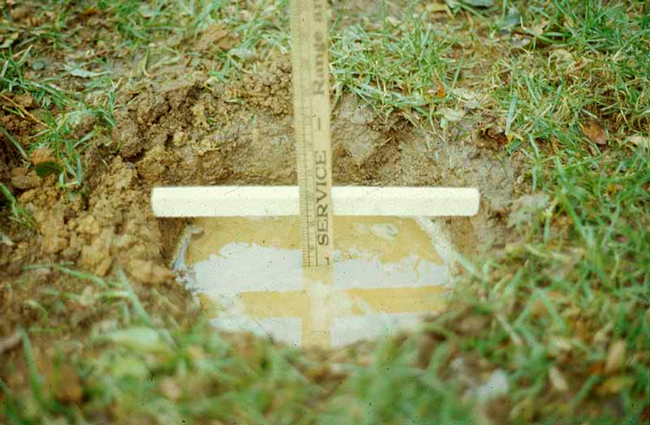
Planting the tree. Dig a hole at least 2-1/2 times the width of the container (in clay or compacted soils make the hole at least 4-5 times wider) up to two inches shallower than the depth of the tree in the container to compensate for settling. Use a shovel or trowel to roughen the soil on the sides of the hole to encourage root growth into the native soil. Remove the tree from the container along with any loose soil that covers the lower part of the trunk. Carefully place the tree in the planting hole, keeping the trunk flare (the area where the trunk widens and connects with the roots) 1-2 inches above the existing grade. Gently fill the hole with the same soil that was removed. Do not add soil amendments or compost, another common cause of circled and kinked roots. Irrigate the tree immediately after planting through the entire root system and slightly deeper. Keep in mind that soils with appreciable clay content absorb water more slowly than sandier soils and need to be watered longer but less often. Water newly planted container trees often through their establishment period, even if they are drought tolerant species. Recently transplanted trees have a small volume of roots that dry out very quickly. Water newly planted trees regularly through the first season. Trees in sandy soils require more frequent watering than do trees in heavier soils. (After trees are fully established, irrigation frequency should be reduced but more water should be added during each irrigation.)
Avoid staking trees unless necessary. Stake trees only if they were staked at the nursery and/or if they are planted in a wind-prone area. Remember to loosen ties on nursery stock before they girdle the trunk. Gently secure any tree requiring staking with two opposing flexible ties on the lower half of the tree, allowing the tree to gently blow in the wind to encourage lower trunk strength. Avoids taking trees tightly, restricting flex. As the tree matures, remember to loosen ties and aim for removing stakes entirely if the tree is self-supporting.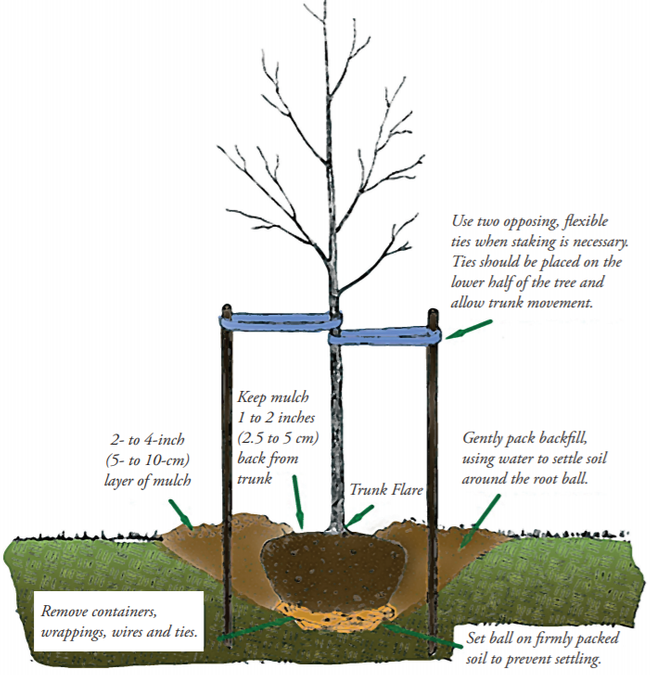
Pruning. Avoid heavy pruning at the time of planting. Remove only broken branches, crossed branches and suckers at the base of the tree.
Fertilizing. Most trees have received adequate nutrition in the nursery and do not need fertilizer at the time of planting.
Mulching. Apply a 2-4 inch layer of mulch three or more inches away from the tree trunk. Organic mulches such as woodchips and compost should be applied and maintained at a depth of 3-4 inches to prevent weed seeds from sprouting. Inorganic mulches (gravel, pebbles, etc.) should be maintained at 2-3 inches. In fire-prone areas, organic mulches near the urban/forest interface should be avoided. Remember to irrigate below the mulch.
For more information on tree planting and care and all other home gardening and landscape topics, contact the UCCE San Bernardino County Master Gardener Helpline at mgsanbern@ucanr.edu
Lush urban forests can help communities face climate change
Urban trees are much more than lovely greenery and stately landscape features. Scientists believe trees are a key tool for combating climate change and living with warming temperatures in California.
UC Cooperative Extension is bringing together municipal and nonprofit organizations, homeowners associations, contractors, the green industry and educators to increase the tree canopy in urban areas by planting recommended species. Nearly 200 people gathered online in March 2021 to share research results, accomplishments and tree canopy growth strategies at the “Trees for Tomorrow Start Today” workshop.
“We need to act now and together to build community forests,” said Janet Hartin, UCCE area environmental horticulture advisor in Southern California and the event organizer. “This is the time to talk about challenges and opportunities for a healthier tomorrow. As our cities grow, so do associated urban heat islands like asphalt-covered parking lots and streets.”
For decades, temperatures have been rising across the planet. While governments work worldwide to reduce carbon dioxide and other emissions that contribute to the greenhouse gases warming the earth, trees are a particularly effective way to make a significant impact on the problem at the local level.
“With proper placement around homes, trees can reduce home energy cost by 30 to 50 percent,” Hartin said. “Treeless urban parking lots can be 20 to 25 degrees hotter than park-like settings in the same area.”
Trees have myriad additional benefits. They provide cooling shade to sidewalks, schools and shopping centers. Trees remove dust from the air, create windbreaks, capture runoff, reduce glare, muffle urban noise and provide a habitat for birds and other animals. In the process of photosynthesis, trees also absorb and store carbon dioxide, helping reduce greenhouse gas emissions to the atmosphere.
With so many reasons to plant and maintain trees in urban communities, and with the overarching threat of climate change, there's no time to waste in nurturing lush green canopies in California cities, schools, parks and neighborhoods. Hartin said ensuring the proper tree selection, placement and care is critical.
“Trees improperly selected or not properly cared for are taking precious time away from the future benefit of trees,” she said.
UC conducts long-term research to identify the best urban trees
Hartin is working with a team of UC Agriculture and Natural Resources and U.S. Forest Service scientists to identify the best drought- and heat-tolerant trees for different areas of the state. Six years ago, the team vetted 100 trees native to California, the Southwest and Australia, taking into account habitat, physiology and biological interactions. A selection of fast-growing, drought-, heat- and pest-resistant species were planted at UC Riverside, the UC South Coast Research and Extension Center in Irvine and in Northern California to be evaluated over 20 years. In addition, Hartin has a subset of trees in a ‘mulch, no mulch' study at Chino Basin Water District in Montclair.
“We're beginning to see the best performers in those areas,” said Hartin, who shared a few of the tree species that have already caught her fancy.
Island Oak (Quercus tomentella) – A disease-resistant evergreen California native adapted to many Sunset magazine zones and soils.
Netleaf Hackberry (Celtis laevigata var. reticulate) – A deciduous tree with small red berries that attract birds. “This is performing beyond our expectations,” she said.
Thornless Honey Mesquite – (Prosopis glandulosa ‘Maverick') – Native to the Southwest U.S., the tree is heat tolerant and cold hardy. It grows as wide as it is tall – about 35 feet.
Pistacia ‘Red Push' (Hybrid of Pistacia atlantica × Pistacia integerrima) – Developed in Arizona, the tree grows 20-feet tall. “The foliage makes you think of Maine or Minnesota in the fall, but this tree has a brilliant red tinge when it first leafs out in the spring,” she said. “It's performing really well in our studies.”
Bubba Desert Willow (Chilopsis lineraris ‘Bubba') – “My favorite tree from our study,” Hartin said. “It grows fast, has beautiful trumpet-like flowers and requires little maintenance.”
Hartin recommends finding more details about these and other trees at http://selectree.calpoly.edu. Read more about the project here: UC study seeks street trees that can cope with climate change.
UC Master Gardeners provide advice on tree selection and maintenance
Proper location based on climate zone and specific conditions around one's home, planting and maintenance are important for tree longevity. Helpful information and support is available throughout California from UC Master Gardener Program volunteers.
Mandy Parkes of the Inland Empire Resource Conservation District said Master Gardeners are a “pivot point” for successful tree planting. She spearheaded a tree planting program in North Redlands that involves partnerships with the California Climate Action Corps, the city, ESRI, University of Redlands and UCCE to encourage residents to plant trees where the urban canopy is currently low.
“New tree owners need long-term support to aid selection and placement of trees,” Parkes said. “Master Gardeners can weigh in on yard design, irrigation and most importantly, guiding trees into the ground and caring for them correctly and in a way that works for the residents.”
Studies have shown that there is often less tree canopy cover in lower-income communities. In many under-served neighborhoods, canopy cover ranges from 0 to 11%, Hartin said, far short of the recommended 25% canopy cover.
“In wealthier neighborhoods, there tends to be higher canopy cover, and in addition, in those areas there is less asthma and cardiovascular disease,” Hartin said. “Encouraging planting in low-income neighborhoods is one of our goals.”
Andy Lyons, program coordinator for UC ANR's Informatics and GIS Statewide Program and a workshop participant said, “GIS technology and data offer exciting new possibilities for managing our urban trees, including the ability to create highly accurate maps of urban trees from aerial imagery, mobile data collection apps to monitor tree health, and the ability to overlay climate change projections for species selection and planning."
Threats to urban trees
Threats to trees were also discussed at the day-long Trees for Tomorrow meeting. West Coast Arborists' Cris Falco said he is frequently dismayed to see poorly pruned trees. “In my opinion, poor tree work is still the rule, not the exception,” he said.
A common mistake is cutting back, or heading, branches, while the goal should be a natural system of pruning to retain and promote characteristic growth. But, with 90% of the urban forest grown on private property, all too often poor tree architecture or inferior branch structure can lead to early tree failure. Falco and other speakers recommended regular pruning by a certified arborist.
Insect pests and diseases can also get in the way of long-term tree survival. Dave Rogers is a recently retired city arborist and currently acting director of the Community Services Department in Claremont, a college town in eastern Los Angeles County known as the “City of Trees and Ph.D.s.” He said the polyphagous shot hole borer reached Claremont and threated to kill heritage oaks and sycamores. Rogers gathered information and shared it with the city council, who provided $300,000 to treat infested trees. “The treatments worked,” he said.
But the pest continues to threaten trees in Los Angeles and Orange counties. One of the promising trees in the Trees for Tomorrow climate study, the Thornless Desert Museum Palo Verde, was found to be susceptible to shot hole borer, so experts are not recommending residents plant this tree.
Another pest, the ash borer, is in Eastern Texas and Boise Idaho, and will likely make its way to the West Coast eventually, said plantsman and workshop participant Nicholas Staddon of Everde Growers.
“It will kill every single ash tree we have,” said Staddon, who was a plant specialist at Monrovia Wholesale Nursery for many years. “We have to look at a broader diversity of trees. From the growers' perspective, trees are the most expensive items we grow. People who want to buy trees need to have some financial skin in the game for growing them.”
Making trees that are climate-tolerant but less common available to the public at nurseries is another hurdle. Nurseries carry what people are asking for, but people don't always know about tested species and even older, “tried and true” varieties.
“We have a list of trees adapted to the climate that are water wise, but at this point, it is difficult to find those in the nurseries,” said Debby Figoni, UC Master Gardener and water administrator for City of Beverly Hills. “It's one thing to know what you're supposed to plant. It's another to find that tree. We have to give people resources.”
The rich discussion regarding the need to enhance tree canopies with recommended species and proper long-term care did not end at the conclusion of the workshop, Hartin said.
“A goal of the workshop was to identify ways to work together more effectively across professions,” she said. “Lots of great ideas came out of the roundtable discussions that we'll be following up on. These include providing education on proper tree selection and care through local task forces consisting of members of the nursery and landscape industry and regular communication between these groups.”
Be part of the solution: Plant drought, heat, and pest resistant trees to combat urban heat islands
Our population of urban trees is shrinking! You can help turn this around by protecting your own trees and by planting new ones recommended for your climate and the conditions around your home. For more on this topic, please revisit my February blog for specific selection and care recommendations: https://ucanr.edu/b/~ZuB.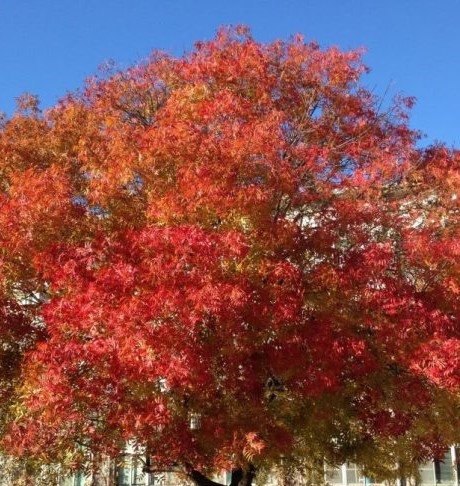
In addition, please encourage your city to plant a wide range of recommended species today for a healthier tomorrow. Why is this so important? Many of our current street trees are in the 11th hour of their lifespans. While some that were planted decades ago are simply aging naturally, in other cases, they are perishing prematurely due to poor selection and care. This leads to a downward spiral; trees not adapted to the climate they're planted in and not receiving proper care are much more susceptible to invasive pests (shot-hole borers, etc.) and diseases than are healthy, well- chosen and maintained trees. Even the loss of one front yard shade tree can significantly reduce shade, increase the surrounding temperature, and diminish energy savings.
Another reason we're losing our trees is due to the negative impacts of urban heat islands (UHIs) which shorten the lifespan of many species of trees dramatically. Some trees (even many natives!) just aren't able to withstand the higher temperatures (sometimes exceeding 20 degrees) they are subjected to due to UHIs.
What are urban heat islands and why should we care? Urban heat islands are caused by reradiated heat from paved concrete and (especially) asphalt surfaces. 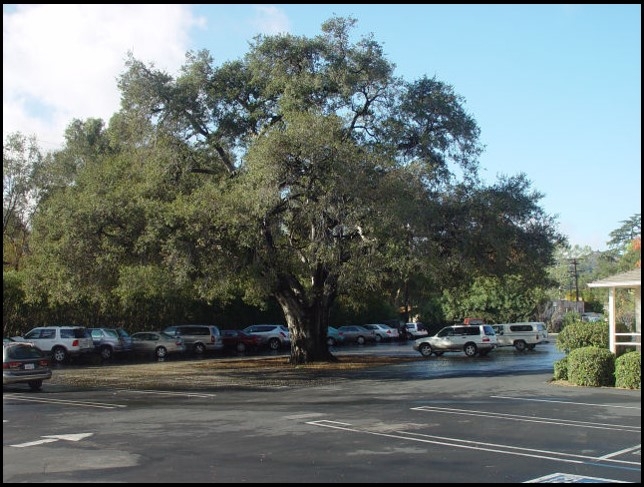
And, our cities are growing and expanding. Very few Southern California residents reside in rural areas. Instead of living near pastures, field-filled crops, and forests that cool the surrounding area through evapotranspiration, the vast majority of us reside in warmer urban city centers. Conditions we expect our city trees to endure in 2021 are very different from even 20 to 30 years alone, let alone decades ago.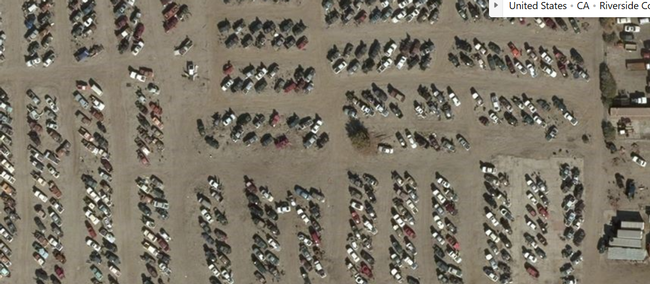
The good news is that, through proper tree selection and care, we can be a part of the solution. In fact, trees offer many benefits that offset the impacts of UHIs. Cities with larger tree canopies are a testament to this fact and have fewer adverse impacts from UHIs than do cities with low tree canopies. Trees reduce the impact of UHIs by shading parking lots, buildings, and vehicles), deflecting the sun's radiation, and cooling the atmosphere through evapotranspiration. Trees also absorb and store carbon which lessens the impacts of pollution from fossil fuels. A well-tended mature landscape tree can absorb 40 tons of carbon over its lifespan.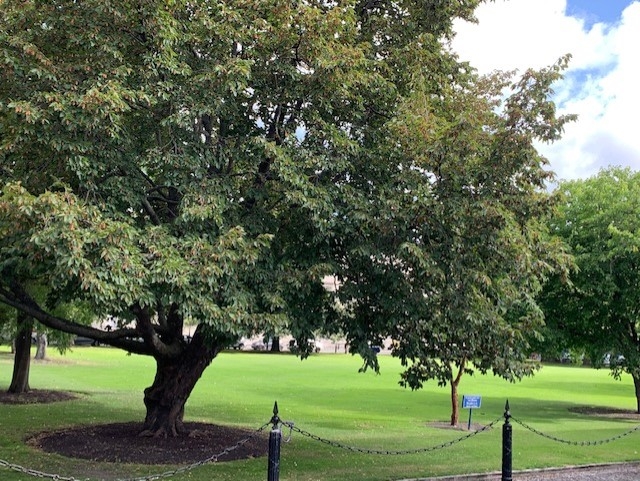
The solution? Augment our current urban tree palettes with heat, drought, and pest-resistant native and adapted non-native species. A case in point of a native tree in trouble is our beautiful Joshua trees (Yucca brevifolia) which are dying off in their namesake National Park and seeding 500 or more feet higher elevation than parent plants. Planting trees that withstand UHIs today is crucial for tomorrow.
We are well on the way to identifying landscape tree species that can remain healthy under adverse urban conditions. In our study examining the performance of 12 species of underplanted but promising landscape trees, several candidates are standing out for their heat, drought, and pest resistance.

